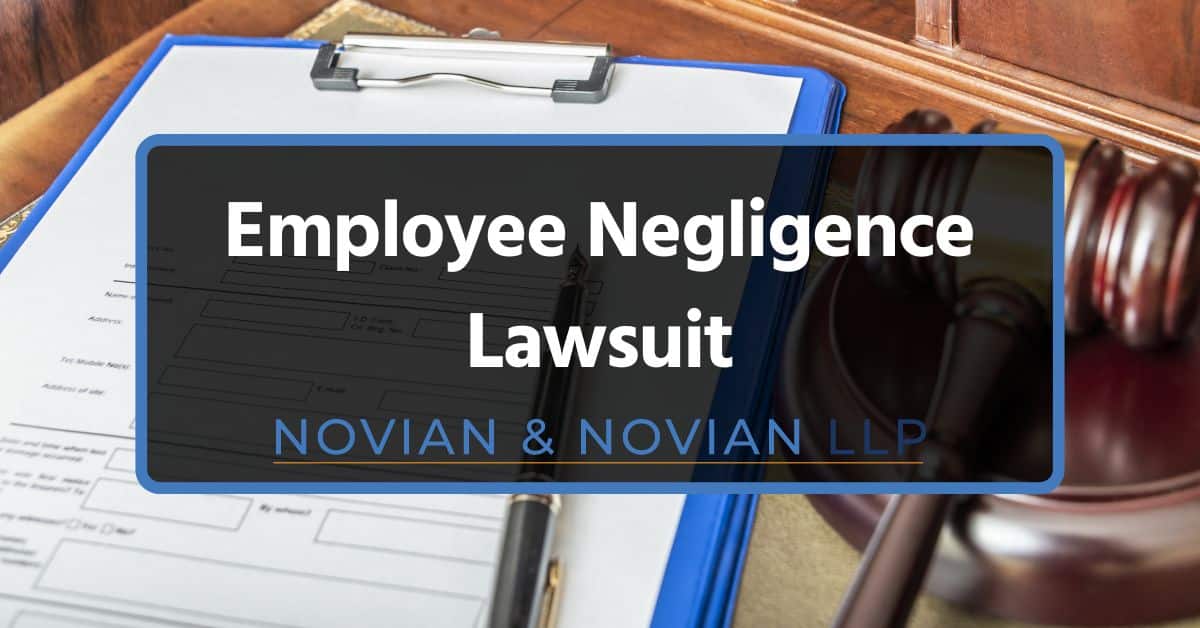
| August 20, 2024 | Employment Law
A negligence lawsuit is a legal action taken against an individual or entity whose careless actions have caused harm to another party. In the context of employment, this means that if an employer knew an employee’s negligent behavior led to damage or injury, the employer could be held liable. This could include scenarios such as an employee causing an accident due to ignoring safety protocols, mishandling equipment, or providing incorrect information to clients.
Employers can sue their employees for negligence if the employee’s actions have directly caused significant harm or financial loss to the company. Common instances include damaging company property or assets, breaching fiduciary duties resulting in financial losses, and failing to adhere to safety regulations, leading to accidents.
At Novian & Novian, we specialize in employment law and offer expert guidance on handling employee negligence lawsuits. With over 30 years of experience, we aim to help employers protect their business interests. Take proactive straps to safeguard your business today by scheduling a free consultation with us!
In this post, we aim to provide a clear understanding of what a negligence lawsuit entails. We will also touch on the types of negligence lawsuits and guide you through the process of suing an employee. In addition, we will talk about appropriate situations in which employers can sue their employees.
What is Employee Negligence?
Employee negligence refers to an employee’s failure to exercise reasonable care in performing their job duties, leading to harm or damage to the employer, co-workers, or third parties. Legally, this can result in implications for both the employee and the employer. When an employee’s actions—or lack thereof—fall short of the standards expected in their role, it can open up legal grounds for negligence claims and lawsuits.
Actions that could count as employee negligence include failure to follow safety protocols and negligent training. It also includes bad equipment handling and a lack of attention to detail. When issues like this arise, an employer can sue an employee.
The first step to dealing with employee negligence is to take immediate action and investigate the issue. As an employer, you have the duty of training and educating your employees to understand safety protocols and job responsibilities.
Depending on the severity, you may have to take disciplinary action to address the negligent behavior. Then, you should regularly review and update company policies to prevent future negligence.
What is an Employee Negligence Lawsuit?
An employee negligence lawsuit is a legal action taken against an employee whose negligent actions or omissions have caused harm or damage to their employer, co-workers, or third parties. Such lawsuits aim to hold the employee accountable and seek compensation for the damages incurred.
The average cost of an employee negligence lawsuit is around $40,000. However, the cost can vary significantly based on factors such as the complexity of the case, attorney fees, court fees, and the duration of the legal process.
The decision to pursue a lawsuit depends on several factors, such as the severity of damages. If the negligent act led to significant financial losses, property damage, or severe injuries, it justifies the costs and efforts of a lawsuit. Furthermore, if the potential compensation outweighs the legal costs and emotional toll, it may be worth pursuing.
A lawsuit typically arises when serious harm occurs. For example, when an employee’s negligence results in substantial injury or damage. It could also arise from failure of internal resolution and legal obligation, especially when the severity of the incident obligates the employer to pursue legal action to protect the company’s interests and comply with regulations.
However, keep in mind that employers might be held liable for negligent supervision if they fail to oversee their employees adequately and it leads to workplace accidents or injuries. Likewise, an employer’s negligence can occur due to an employer’s failure to provide proper safety equipment, training, or supervision, leading to an employee’s workplace injury.
Workers Compensation System for Workplace Injuries
The workers’ compensation system exists to provide financial support and medical care to employees who suffer workplace injuries. It operates on a no-fault system, meaning employees can receive benefits regardless of who was at fault for the injury.
Typically, a workers compensation claim helps cover medical expenses and lost wages. This could be costs for medical treatment, rehabilitation and ongoing care, or compensation for income lost due to inability to work.
When is an Employer Liable for the Negligence of an Employee?
An employer can be held liable for the negligence of an employee under certain conditions like vicarious liability. Here, employers may be held responsible for employees’ negligent actions performed within the scope of their employment.
Employers can also be liable for negligent supervision. This is a failure to properly supervise employees, leading to a lack of oversight that results in harm.
Furthermore, employers can be liable due to negligent training and negligent retention. These refer to inadequate training that leads to errors or accidents, and retaining employees known to be negligent or dangerous can result in employer liability.
Elements of a Negligence Lawsuit
A successful negligence lawsuit requires proving certain key elements. These include Duty of Care, Breach of Duty, Causation, and Damages. Each element plays a crucial role in establishing the liability of the responsible party, whether it’s an employee or employer.
- Duty of Care: Duty of care refers to the legal obligation of an individual or entity to act with a certain standard of care to avoid causing harm to others.In the context of an employee negligence lawsuit, employees have a duty to perform their job responsibilities with reasonable care to prevent workplace injuries and accidents. Employers, too, must ensure a safe work environment, provide proper safety equipment, and carry workers’ compensation insurance to protect employees.
- Breach of Duty: A breach of duty occurs when an individual or entity fails to meet the standard of care required by their duty of care. This can manifest in various forms, such as poor supervision, inadequate training, or failure to provide necessary safety equipment. For example, if an employer’s negligence in training employees or maintaining equipment leads to a work injury, it constitutes a breach of duty. Similarly, if an employee acts recklessly or ignores safety protocols, they breach their duty of care.
- Causation: Causation is the direct link between the breach of duty and the harm caused. To prove causation in a negligence claim, it must be shown that the breach of duty directly caused the injury or damage. For instance, if an employee fails to use proper safety equipment and sustains a serious injury, the lack of safety measures can be directly linked to the injury. On the other hand, employers may be held liable if their failure to supervise or provide a safe environment results in harm to employees.
- Damages: Damages refer to the actual harm or loss suffered as a result of the breach of duty. In a negligence lawsuit, damages can include medical expenses, lost wages, and compensation for pain and suffering. Typically, workers’ compensation benefits also cover these aspects, providing benefits to injured employees under a no-fault system. If an employer intentionally injured an employee, or if their negligence caused significant harm, the injured worker might seek maximum compensation through a personal injury lawsuit.
Types of Employee Negligence
Employee negligence can take many forms like theft, breach of contract, trade secrets, etc. Each of these forms can potentially lead to significant harm or damage to an employer’s business.
Some major types of employee negligence include:
Theft: Theft involves an employee unlawfully taking company property or funds. This can include stealing physical items, cash, or digital assets. Theft not only results in direct financial loss but can also damage trust and morale within the organization.
Trade secrets: This entails mishandling or unauthorized disclosure of confidential business information. Employees may negligently share trade secrets, either intentionally or unintentionally, with competitors or other unauthorized parties. This can severely impact the company’s competitive edge and market position.
Defamation: Defamation involves making false statements that harm the reputation of the company or its employees. These defamatory statements can be made in public forums, social media, or within the workplace. They typically lead to a damaged reputation and potential legal consequences as people start doubting the authenticity of your organization.
Breach of contract: A breach of contract occurs when an employee or employer fails to adhere to the terms and conditions of employment agreements. This includes not fulfilling job responsibilities, violating non-compete clauses, or disclosing confidential information. Breach of contract can result in legal disputes and financial penalties.
Failure to follow safety protocols: Neglecting to adhere to established safety procedures and regulations can lead to workplace accidents, injuries, and increased liability for the employer. Examples include failing to report hazards or improper handling of safety equipment.
Negligent operation of vehicles: This could include reckless driving, not following traffic laws, or improper maintenance of vehicles. Such actions can result in accidents, injuries, and property damage.
Improper Handling of dangerous materials: This negligence can lead to spills, contamination, or injuries, posing serious risks to employee safety and the environment. Therefore, proper training and adherence to safety protocols are essential.
Errors in financial management: These include mistakes in budgeting, accounting, or financial reporting. They can lead to significant financial losses, legal issues, and damage to the company’s credibility.
The decline of the company’s reputation: This involves employees engaging in actions that negatively impact the public perception of the company. This can result from any of the aforementioned negligent behaviors. A tarnished reputation can lead to loss of customers, reduced revenue, and long-term damage to the brand.
Legal Framework Around Employee Negligence Claims
Employee negligence claims are governed by a variety of laws and regulations that vary by jurisdiction. These legal frameworks establish the duties and responsibilities of both employees and employers to ensure a safe and lawful working environment.
For example, the Occupational Safety and Health Act (OSHA) is a federal law that requires employers to provide a workplace free from recognized hazards that can cause death or serious physical harm. Thus, employers must comply with OSHA standards and ensure that employees have proper safety training and equipment.
There is also the Fair Labor Standards Act (FLSA) that governs minimum wage, overtime pay, and child labor standards. Employers must comply with FLSA regulations to prevent negligence in employee compensation.
In California, there is the California Labor Code that includes various provisions related to workplace safety, wage and hour laws, and workers’ compensation. Employers in California must comply with these regulations to avoid negligence claims. There is also the California Fair Employment and Housing Act (FEHA) that prohibits employment discrimination and requires employers to take reasonable steps to prevent discrimination and harassment in the workplace.
Typically, employers have a legal duty to prevent negligence and ensure a safe working environment. Key responsibilities include providing proper training, implementing safety protocols that comply with OSHA standards, maintaining safe work conditions, and supervising employees. Employers should also maintain workers compensation insurance. This insurance is a critical component of the no-fault workers compensation system.
Step-by-Step Process of Suing an Employee for Negligence
If you want to sue an employee for negligence, here’s a step-by-step process:
1. Documenting the Incident and Gathering Evidence
The first step in suing an employee for negligence is to thoroughly document the incident and gather all relevant evidence. The various types of necessary evidence could include incident reports, witness statements, photographs of the scene, and any other physical evidence. Also, gather medical reports if there were injuries and records of damaged properties. It could also include an employee write-up if you’ve had to write up an employee.
Next, you have to prove that the employee had a duty of care towards the employer or co-workers. This involves showing that the employee was responsible for certain tasks or safety measures.
Then, provide evidence that the employee breached their duty of care. This could include failure to follow safety protocols, improper handling of dangerous materials, or negligent operation of vehicles.
Furthermore, show a direct link between the breach of duty and the harm caused. For example, if an employee’s failure to use proper safety equipment resulted in a workplace accident.
Additionally, document the actual harm or losses incurred, such as medical bills, lost wages, and damage to company property.
2. Consulting a Legal Lawyer
In suing an employee for negligence, you should consult and work with an experienced legal lawyer. A lawyer can assess the evidence collected to determine the strength of your case. They will also provide expert advice on the best course of action and potential outcomes and assist in drafting the necessary legal documents and filings.
At Novian & Novian, we have experienced attorneys who will help you navigate the complexities of an employee negligence lawsuit. With over 30 years of experience, we pride ourselves on applying empathy when working with employers to achieve the best possible results. Contact us now for a free consultation to discuss your case.
3. Filing a Negligence Lawsuit
The process of filing a negligence lawsuit involves submitting a formal complaint to the appropriate court. This document outlines the nature of the negligence, the evidence supporting your claims, and the damages you seek.
Then, you have to legally serve the employee with the complaint and a summon to appear in court. This ensures the employee is officially notified of the lawsuit. Additionally, ensure that you follow through with pre-trial procedures. This includes discovery (exchange of evidence), possible settlement negotiations, and, if necessary, a court trial.
The Possible Outcomes of a Legal Battle
When engaged in a legal battle over an employee negligence lawsuit, several possible outcomes can emerge. The case could either end in a settlement or go to court. Below, we will provide more detailed contexts for each scenario.
Legal outcome – Settlement
A settlement is an agreement reached between the parties involved, often facilitated by their legal representatives. This outcome avoids a court trial and is usually faster and less costly.
During the process, there would be a negotiated agreement where the terms of the settlement will be negotiated. Then, both parties must agree to the conditions. This may include compensation for damages, changes in workplace practices, or other agreed-upon terms.
There would also be a provision for confidentiality clauses. Many settlements include confidentiality clauses to prevent the details of the agreement and the case from being disclosed publicly. This can protect the reputations of both parties and maintain privacy.
Legal outcome – Court
If the parties cannot reach a settlement, the case will proceed to court. Here, a judge or jury determines the outcome. The court may award compensatory damages to the plaintiff to cover losses such as medical expenses, lost wages, and other costs directly related to the injury. In cases of gross negligence or intentional harm, the court may award punitive damages to punish the defendant and deter future misconduct.
Furthermore, the losing party may be required to pay court costs and legal fees, which can be substantial. The court may also issue cease and desist orders to stop certain behaviors or practices that contributed to the negligence.
In some cases, the court may order the reassignment of the negligent employee to a different position or duties within the company. Additionally, the employer may take disciplinary actions against the employee, such as suspension, demotion, or termination, based on the court’s findings.
Settlement vs. Court
Settlements are a faster resolution compared to a court trial. They have lower legal costs and court fees, and you can also have privacy through confidentiality clauses. In addition, you have greater control over the outcome and terms with settlements.
However, these settlements may result in lower compensation compared to a court award. It is also important to keep in mind that no legal precedent is set through settlements.
On the other hand, there is potential for higher compensation through compensatory and punitive damages if the case goes to court. You can also establish legal precedent and there would be public record of the court’s decision. This may serve as a deterrent for future negligence.
Conversely, court cases can be lengthy and stressful. They also involve higher legal costs, court fees, and loss of privacy.
Preventative Measures for Employers
To minimize the risk of employee negligence and potential legal claims, employers must implement certain preventative measures. These strategies not only protect the company but also ensure a safer and more productive workplace.
One of such strategies is ensuring detailed candidate vetting during the hiring process. This includes background checks, reference checks, and verifying qualifications and experience. By doing this, you are reducing the risk of hiring individuals who may cause workplace injuries or engage in negligent behavior.
Another helpful strategy is to have clear job descriptions and expectations. This helps employees understand their roles and responsibilities. Thus reducing confusion and eros that could lead to negligence claims.
Furthermore, employers should make provision for continuous skills development. This helps to enhance employee competency, reducing the likelihood of negligent training and errors in financial management.
As an employer, you also need to establish strong policies and procedures to ensure consistent practices across the organization. By doing this, you are reducing the risk of negligence and ensuring compliance with safety standards. Likewise, there should be implementation of proactive safety protocols, including regular safety training and providing proper safety equipment to ensure a safe working environment. Having such protocols prevents workplace injuries, reduces the need for workers’ compensation claims, and protects the company from employer negligence lawsuit settlements.
In addition, there is a need for effective supervision and oversight. Supervisors should actively monitor and support other employees, to ensure they are following procedures and performing their duties correctly. This prevents negligent supervision claims and ensures any issues are addressed promptly before they escalate.
Moreover, you should encourage employees to have a culture of detailed incident reporting immediately. It helps identify potential hazards and areas for improvement. Thus, allowing for timely interventions and corrective actions to prevent future incidents and reduce liabilities.
There should also be consistent consequence management. When this is in place, it deters negligent actions and maintains high standards of conduct within the workplace.
Importantly, employers should encourage a positive workplace environment. This reduces the likelihood of negligent behavior and improves overall employee morale and productivity.
Benefits of Hiring an Employment Lawyer
An employment lawyer specializes in handling legal issues related to the workplace, including employee rights, workplace discrimination, wrongful termination, harassment, wage and hour disputes, and employment contracts. They represent both employers and employees, providing legal advice, drafting legal documents, and representing clients in court.
An employment lawyer ensures your business complies with all relevant labor laws and regulations, reducing the risk of legal disputes. They provide expert advice on complex employment issues, helping you make informed decisions.
In addition, an experienced attorney mediates disputes to reach amicable resolutions without the need for litigation. Similarly, they represent your interests in negotiations and legal proceedings. Furthermore, employment lawyers are helping in implementing policies and practices to prevent legal issues from arising.
Furthermore, the cost of hiring an employment lawyer can vary widely based on several factors, including the complexity of the case, the lawyer’s experience, and the geographical location. On average, they charge between $300 to $1,500 per hour.
The duration of legal processes involving employment matters can vary based on the nature and complexity of the issue. Typically, the initial consultation and early steps, such as gathering evidence and filing complaints, can take a few weeks to a few months. If disputes are resolved through mediation or settlement, the process can take several months. But if a case goes to court, it may take a year or more, depending on court schedules and the specifics of the case.
Want to Sue an Employee for Negligence?
Employee negligence can lead to significant financial losses, legal disputes, and damage to your company’s reputation. Employers must implement comprehensive preventative measures such as detailed candidate vetting, clear job descriptions, continuous skills development, strong policies and procedures, proactive safety protocols, effective supervision, detailed incident reporting, consistent consequence management, and fostering a positive workplace environment.
When negligence occurs, it’s important to document the incident thoroughly, consult an experienced legal lawyer, and understand the potential outcomes of a legal battle. Whether you choose to settle out of court or pursue a lawsuit, having an experienced attorney by your side can make a significant difference.
If you need professional legal assistance to sue an employee for negligence or to protect your business from potential legal disputes, contact us at Novian & Novian. Our Los Angeles Employer Defense Practice offers expert guidance and representation to ensure your business is safeguarded against employee negligence claims.
Contact Us
Have questions about this post? Novian & Novian is a full service law firm in Los Angeles with clients that span the country. Contact us today for a free consultation.
Contact Us
Have questions about this post? Novian & Novian is a full service law firm in Los Angeles with clients that span the country. Contact us today for a free consultation.




